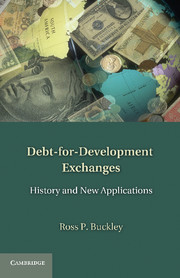Book contents
- Frontmatter
- Contents
- Acknowledgments
- List of Contributors
- Introduction: A Productive Partnership between Civil Society and the Academy
- Part I Types of Exchanges and Their Development over Time
- Part II Exchanges by Donor Countries
- Part III Critiques of Exchanges
- Part IV Innovative Applications of Exchanges
- 15 Farmer-Managed Natural Regeneration: A Land Rehabilitation Technique Well Adapted to Funding by Exchanges
- 16 Restoring Mangroves in the Philippines
- 17 Poverty Reduction through Social Protection: A Potential Form of Debt-for-Development Exchange
- 18 Climate Change Adaptation Exchanges: An Exploration of the Possibilities and Risks
- 19 Climate Change and Food Security: Building Resilience by Means of Climate Field Schools
- 20 Debt-for-Security Exchanges
- 21 Promoting Good Governance through ICT Systems: Improving Transparency and Reducing Corruption
- 22 Using Debt Exchanges to Enhance Public Accountability to Citizens
- Conclusion
- Index
- References
19 - Climate Change and Food Security: Building Resilience by Means of Climate Field Schools
Published online by Cambridge University Press: 01 June 2011
- Frontmatter
- Contents
- Acknowledgments
- List of Contributors
- Introduction: A Productive Partnership between Civil Society and the Academy
- Part I Types of Exchanges and Their Development over Time
- Part II Exchanges by Donor Countries
- Part III Critiques of Exchanges
- Part IV Innovative Applications of Exchanges
- 15 Farmer-Managed Natural Regeneration: A Land Rehabilitation Technique Well Adapted to Funding by Exchanges
- 16 Restoring Mangroves in the Philippines
- 17 Poverty Reduction through Social Protection: A Potential Form of Debt-for-Development Exchange
- 18 Climate Change Adaptation Exchanges: An Exploration of the Possibilities and Risks
- 19 Climate Change and Food Security: Building Resilience by Means of Climate Field Schools
- 20 Debt-for-Security Exchanges
- 21 Promoting Good Governance through ICT Systems: Improving Transparency and Reducing Corruption
- 22 Using Debt Exchanges to Enhance Public Accountability to Citizens
- Conclusion
- Index
- References
Summary
INTRODUCTION
Climate change has been described as the greatest challenge that humankind will face in the 21st century. It encompasses both gradually altered weather patterns and extreme climatic events. Irrespective of its root cause, whether anthropogenic or part of ongoing natural processes, climate change has the potential to cause significant social and economic disruption across the globe. Agriculture has been consistently identified as one of the most vulnerable sectors due to its dependence on environmental resources and weather patterns. This in turn poses serious food security concerns for the globe. Key stakeholders in the resulting security dilemma are the farming populations of developing countries whose livelihoods are particularly at risk.
This chapter will explore the potential for climate field schools to address the effect of climate change on food security. First, we highlight how developing countries are acutely vulnerable due to the more pronounced impact climate change has on agricultural production. Second, we propose the use of debt-for-development exchanges to fund climate field schools for farmers as a fruitful adaptation strategy to build resilience and coping capacity.
CLIMATE CHANGE AND REDUCED AGRICULTURAL POTENTIAL
The increased intensity and frequency of extreme climatic events has been attributed to climate change. Damages from floods, droughts and windstorms amounted to US$31 billion damage and almost 24,336 deaths in Southeast and South Asia from 1994 to 2003. It is clear that both gradual and acute environmental strains due to climate change have diminished livelihoods and hampered development in these regions.
- Type
- Chapter
- Information
- Debt-for-Development ExchangesHistory and New Applications, pp. 236 - 246Publisher: Cambridge University PressPrint publication year: 2011



